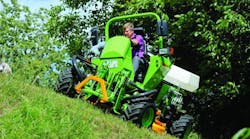MCR radial-piston motors allow easy freewheeling, an important element of Bosch Rexroth’s High Efficiency Control drive.
On the road, with the series connection active, fuel consumption would normally increase sharply when speed exceeds 40 km/hr. This is because each wheel traces a slightly different curve during travel and causes continuous application of pressure without a load actually being applied. To avoid this, the operator can select from several operating modes for the LinsiTrak’s hydrostatic drive system. The series connection is disabled for on-road operation. In this mode, only the rear wheel motor in each circuit provides propulsion. Power for forward travel is applied entirely at the rear wheels, providing high traction during acceleration.
In contrast, hydrostatic braking with LinsiTrak acts almost exclusively on the front wheels. This is especially important when travelling downhill because weight shifting to the front axle improves the effect of braking at the front wheels. When travelling forward on flat surfaces, the front wheels simply freewheel in the hydraulic circuit. Driving wheels individually in this way saves fuel.
A proprietary HET valve from Rexroth thus disables the series connections and applies only the required amount of pressure to the front wheels. This active or inactive series mode option ensures that the drive is easy on the environment at all times and under all circumstances. The HET valve also provides a third option, its offset mode. The offset mode changes the track (distance) between the front and rear wheels. So instead of following directly behind the front wheels, the rear wheels will roll either outside or inside the track of the front wheels. This is useful when traveling over ground that is sensitive to compaction.
Motors contribute to success
Freewheeling in the MCR radial-piston motor is achieved by connecting its A and B ports to zero pressure while also applying a pressure of 2 bar to the housing. The housing pressure forces pistons into the cylinder block, which causes the motor’s cam rollers to lose contact with the cam thus allowing free rotation of the shaft.
If the motors are used in a closed circuit, the same hydraulic fluid continuously flows between the pump and the motor, which could lead to overheating. A flushing valve option in the MCR motor replaces hydraulic fluid in the closed circuit with fluid from the reservoir.
When the hydraulic motor operates under load, the flushing valve opens and takes a fixed flow of fluid through an orifice from the low-pressure side of the circuit. This flow is then fed to the motor housing and back to the reservoir, and normally through an oil cooler.
To charge the low-pressure side of the circuit, cool fluid is drawn from the reservoir by the power unit’s charge pump and fed to the pump inlet through a check valve. The flushing valve ensures a continuous renewal and cooling of the hydraulic fluid. The flushing feature incorporates a relief valve which is used to maintain a minimum boost pressure and operates at a standard setting of 14 bar.
MCR motors also have a two-speed option to drive a vehicle at high speed under low load. This is accomplished through an integrated valve that directs hydraulic fluid to only one half of the motor while continuously re-circulating the fluid in the other half. This reduced displacement mode reduces the flow required for a given speed, thereby improving efficiency.
Bosch Rexroth offers spool valve that provides smooth switching to reduced displacement while the vehicle is on the move. The spool valve requires either an additional sequence valve or electroproportional control to operate in its soft-shift mode.
The drive for control
Of course, hydraulics is used for more than propulsion, braking, and steering. LinsiTrak uses another axial piston pump to power implements such as mower and mulcher blades or sweepers. Several attachment points are located between the vehicle’s front and rear axles to match a variety of implements, which can be attached without tools. As with the HET control drive, the LinsiTrak’s power take-off provides maximum energy efficiency from its stepless speed control that allows the vehicle’s engine to run at its most efficient speed.
In spite of its many functions and elaborate technology, the LinsiTrak is a compact and easy-to-steer unit. Even on 45° slopes, the driver’s seat is always horizontal, thanks to an automatic tilt feature. Inclinometers continuously transmit the angle of the vehicle’s orientation to the electronic control, which then keeps the seat level using hydraulics.
Multiple functions for the various work tools are also implemented through electronic control. Any fine adjustments can be made using a color display from the driver’s seat. By the time these functions are programmed the LinsiTrak will also have adopted its final form – the roll bar has to be slightly higher, the vehicle is to be a total of about twenty centimeters shorter and an optional cab will be available.
Information on the LinsiTrak was provided by Werner Müller, general manager of Müller Landmaschinen.
For more information on Bosch Rexroth’s High Efficiency Traction control and affiliated products, visit www.boschrexroth-us.com.




